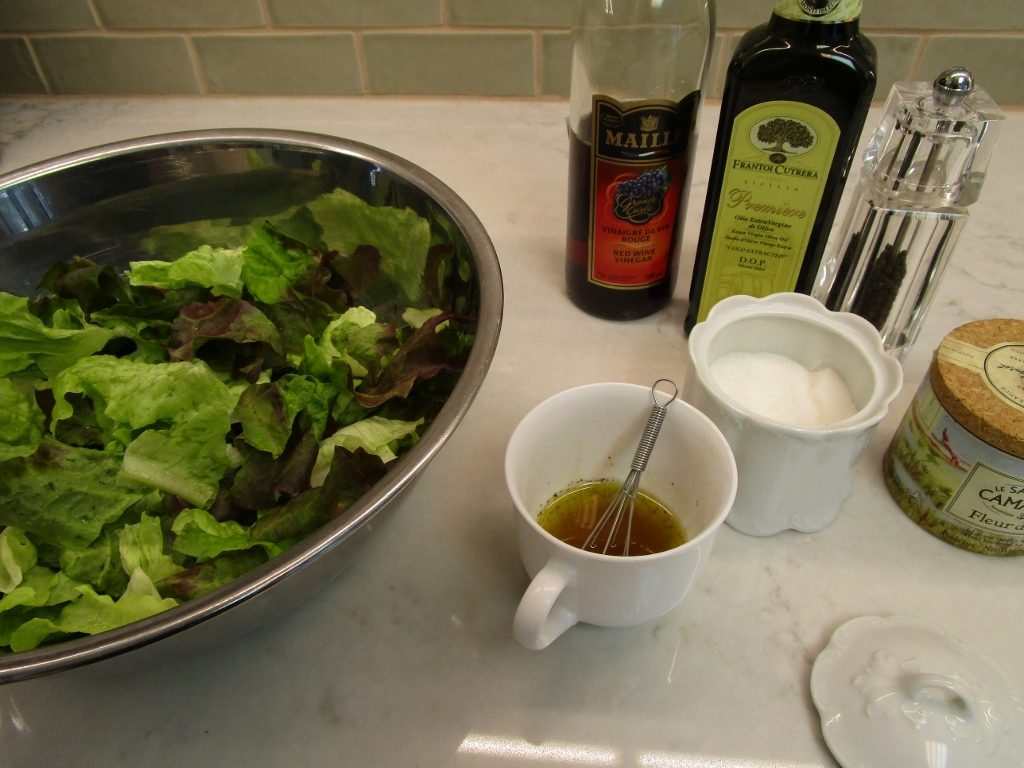Bottled salad dressings are certainly convenient, but they are not necessary. I don’t mean to get preachy, but you know they’re expensive and they take a lot of space in your fridge.
Salad dressings back in the day
What did people do before there were bottled dressings? My grandmother, who established her cooking habits before they were widely available, made just one kind of dressing all her life. It was simply vegetable oil and white vinegar, a dash of salt and pepper, and a pinch of sugar.
She put that on salads of iceberg lettuce or shredded cabbage. For the tender leaves of lettuce from her garden, she used cereal cream instead of oil.
By the 1960s, Kraft bottled dressings were everywhere in Western Canada.
The refrigerator in our house carried Kraft’s most popular selection—Thousand Island, French, Italian, and Creamy Cole Slaw, usually all at the same time. Why so many? I wonder if it was because our salad ingredients were always the same and we thought we’d eat more if we had variety. More likely, they were just so convenient to buy.
These salad dressings took a lot of space in the fridge—and we never knew how old some of those bottles were.
Today, the range of pre-made salad dressings on the market is huge–you can fill your fridge with one or many. But you know in your heart that the longer the shelf life, the less likely they are to be healthy and nutritious.
Pitfalls of salad dressing recipes
If you want to make your own, you’ll find thousands of recipes in cookbooks and on the Internet. However, you may find that most recipes seem suited for special events and large parties. The yield is always much more than you can use–which means storing the rest in the fridge (until you finally throw it out).
Whenever I followed salad dressing recipes to the letter, the proportions were not always right for my ingredients or my tastes. If I didn’t have the knowledge and confidence to adjust recipes, I would be stuck and disappointed.
You can make your own perfectly-proportioned and sized salad dressing. All it takes is ingredients in your cupboard and less than five minutes of your time. The money and fridge space you save will be bonus. And no, you don’t need a special dressing mixer or shaker.

What’s in a salad dressing—the Basics
Salad dressings contain the following components:
- fat: oil, cream, buttermilk
- acid: vinegar, lemon juice, buttermilk
- sweetener: sugar, honey, balsamic vinegar
- optional emulsifier: Dijon mustard
- various optional flavourings: garlic, shallots, peppers, Dijon mustard or dry mustard, herbs, and salt and ground or cracked pepper
Emulsification is the blending of oil with water.
Vinegar and lemon juice behave like water.
Emulsification is improved by adding Dijon mustard. However, vigorous mixing will also do the trick.
Oils
Most salads are based on lettuce, cabbage or other crunchy vegetables, potatoes, tomatoes, cucumbers, or pasta. For lettuce and tomatoes, extra virgin olive oil works well. But potatoes, cabbage, and cucumbers need a more neutrally-flavoured oil, like canola or other vegetable oil.
Cold pressed oils are perfect for salads. They have superb flavour and nutritional value (lots of omegas) when used unheated. They are more expensive, but you would probably use them only for salads and not for frying.
- Extra virgin olive oil is a cold pressed oil.
- For a vegetable oil, you can get cold-pressed canola oil. My go-to vegetable oil is cold pressed camelina, a tiny seed from a plant related to the mustard.
Vinegars
Three types of vinegar can cover a wide range of salads:
- Red wine vinegar for salads with lettuce or tomatoes or pasta
- Rice wine vinegar for cucumbers and cabbage
- Apple vinegar for potatoes or pasta.
How to make an oil-based salad dressing
- In a cup or a small bowl, pour in about two tablespoons or more of oil, depending on how big your salad is.
- Add an equal quantity or less of vinegar or lemon juice, or both.
- If you are using Dijon mustard, add it now—a small blob will do.
- Add the remaining ingredients, if you are using them:
- sweetener—a pinch of sugar, a teaspoon of honey, a few drops of balsamic vinegar.
- salt
- pepper
- garlic, shallots, dried herbs
- Whisk with small whisk, or a fork, until blended.
- Taste: Take a small item from your salad ingredients (lettuce leaf, chunk of cucumber, macaroni), dip it in the dressing, and taste. Adjust the oil, acid, and other components until you are satisfied.
- Pour the dressing over the salad, add the finishing touches (cracked pepper, chopped herbs), and toss.
And that’s it! You have made a beautiful salad with a healthy and nutritious dressing that is perfectly matched to your ingredients and your tastes.